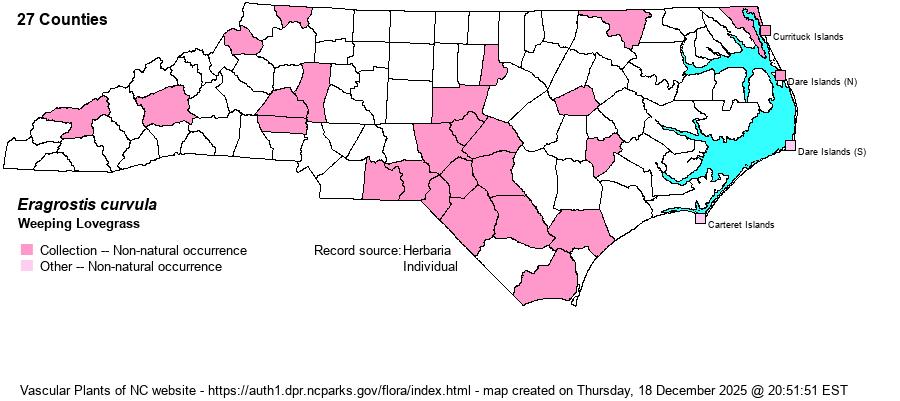| Author | (Schrader) Nees | |
| Distribution | Mostly Sandhills and southern Coastal Plain; scattered in the Piedmont, Mountains, and northern Coastal Plain. Grown at the Soil Conservation Service land in Orange County beginning in 1941.
Native of Southern Africa; in N.A. mostly in the southern U.S., ranging north coastally to MA and WA. | |
| Abundance | Common in the Sandhills proper, frequent in the Coastal Plain and northern Outer Banks, uncommon in the lower Piedmont, rare in the Mountains. | |
| Habitat | Xeric to dry roadsides, woodland openings, powerlines, maritime dry grasslands, disturbed areas. Planted as a soil stabilizer by state and federal agencies (Fort Bragg, Camp Mackall, game lands, NC DOT) and established locally. It tolerates fire well, but does not invade natural, fire-maintained Longleaf Pine-Wiregrass communities -- so far. | |
| Phenology | Flowering and fruiting May-July. | |
| Identification | Weeping Lovegrass grows as a tussock from a hard rhizome. The leaves are very numerous, very slender, and look a lot like Carolina Wiregrass (Aristida stricta). However, the leaves are relatively flat in the basal 1/2 to 2/3, and usually folded in the outer portion (vs. involute-rounded throughout). The inflorescence grows atop a slender, tall culm; it is dark gray in color and has spreading branches, thus is very unlike Wiregrass. | |
| Taxonomic Comments | Species in the genus Eragrostis -- the lovegrasses -- often have inflorescences that are larger than the rest of the plant. Such inflorescences are very open and airy, but other species have more contracted inflorescences. Each spikelet is laterally compressed and contains few to many florets, which lack awns. | |
| Other Common Name(s) | | |
| State Rank | SE | |
| Global Rank | GNR | |
| State Status | | |
| US Status | | |
| USACE-agcp | | |
| USACE-emp | | |

